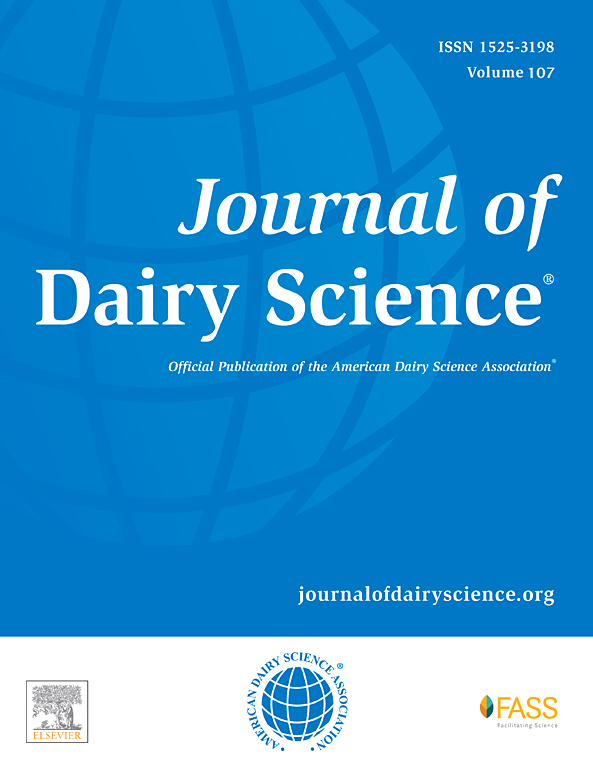初产奶牛首次授精前的定制自愿等待期。对产奶量、繁殖力和健康的影响。
IF 3.7
1区 农林科学
Q1 AGRICULTURE, DAIRY & ANIMAL SCIENCE
引用次数: 0
摘要
在瑞典的 18 个商业奶牛场测试了首次授精前的定制自愿等待期(VWP),以评估适合延长自愿等待期的初产奶牛的产奶量、繁殖力和健康状况。根据泌乳早期的 3 个标准来选择奶牛进行延长输精程序:1)基因组持续率指数最高的 10%奶牛;2)泌乳期第一个月出现难产或疾病的奶牛;3)产后第 4-33 天的产奶量高于初产牛群平均水平的奶牛。至少符合其中一个标准的奶牛被随机分配到 ExtExt 处理(延长产程至少 175 d,n = 174;产仔间隔 (CInt) = 16.3 mo)或 ExtConv 处理(常规产程最长 100 d,n = 173;产仔间隔 (CInt) = 12.4 mo)。不符合任何标准的奶牛被分配到 ConvConv 处理(常规 VWP,n = 183;CInt = 12.0 mo)。虽然ExtExt奶牛的305天产奶量和全泌乳期产奶量(WL)(分别为10,371和13,803千克)高于ExtConv奶牛(分别为9,812和10,257千克),但CInt处理之间的日产奶量没有差异。干奶前最后一次试挤奶时,ExtExt 奶牛的产奶量低于 ExtConv 奶牛(24.9 对 28.3),但结果表明,不同处理间的干奶期长度没有差异。在繁殖性能方面,与ExtConv奶牛相比,ExtExt奶牛的初配受胎率(FSCR;60% vs. 45%)较高,而每次受精的次数(NINS;1.67 vs. 2.19)较低。正如预期的那样,ConvConv奶牛在305-d、WL和CInt中的日产奶量最低,但是,ConvConv奶牛的FSCR和NINS与其他两种VWP处理中的奶牛没有差异。与ConvConv处理相比,ExtConv处理的奶牛疾病发生率更高,但ExtExt与其他两种VWP处理之间没有差异。此外,在乳房健康状况良好的奶牛比例或淘汰率方面,所有处理方法之间均未发现差异,但由于发病率较低,研究缺乏足够的力量就这些结果得出重要结论。因此,在不影响产奶量或延长干奶期长度的情况下,延长适合初产奶牛的VWP可产生诸多益处,如通过提高FSCR和降低NINS的形式提高繁殖力,以及降低干奶产量。本文章由计算机程序翻译,如有差异,请以英文原文为准。
Customized voluntary waiting period before first insemination in primiparous dairy cows: Effect on milk production, fertility, and health
A customized voluntary waiting period (VWP) before first insemination was tested in 18 commercial dairy herds in Sweden to assess milk production, fertility, and health in primiparous cows expected to be suited for extended VWP. Cow selection for extended VWP was based on 3 criteria in early lactation: (1) the 10% of cows with highest genomic persistency index, (2) cows with a difficult calving or disease during the first month of lactation, and (3) cows with higher yield during d 4 to 33 after calving than the herd average for primiparous cows. Cows meeting at least one of these criteria were randomly assigned to either treatment with an extended VWP of at least 175 d (ExtExt; n = 174, calving interval [CInt] = 16.3 mo) or treatment with a conventional VWP of a maximum of 100 d; (ExtConv; n = 173, CInt = 12.4 mo). Cows not meeting any of the criteria were assigned to the conventional VWP treatment (ConvConv; n = 183, CInt = 12.0 mo). We found no differences in milk yield per day in the CInt between treatments, although 305-d and whole-lactation (WL) milk yields were higher for ExtExt cows (10,371 and 13,803 kg) than ExtConv cows (9,812 and 10,257 kg). Milk yield at the last test milking before dry-off was lower in ExtExt compared with ExtConv cows (24.9 vs. 28.3 kg), but the results showed no difference in dry period length between the treatments. Regarding reproductive performance, the ExtExt cows had a higher first service conception rate (FSCR; 60% vs. 45%) and lower number of inseminations per conception (NINS; 1.67 vs. 2.19), compared with the ExtConv cows. As expected, ConvConv cows had the lowest milk yield (305-d, WL, and per day) in the CInt; however, FSCR and NINS did not differ between ConvConv cows and cows in the other 2 VWP treatments. Disease incidence was higher for cows in the ExtConv compared with the ConvConv treatment, but there was no difference between ExtExt and the 2 other VWP treatments. Further, no difference in the proportion of cows with good udder health or culling rate was detected between any of the treatments, though due to low prevalence, the study lacked power to draw major conclusions on these results. Thus, prolonging VWP for suitable primiparous cows can produce benefits such as improved fertility in the form of higher FSCR and lower NINS, as well as lower dry-off yield, without compromising milk yield or prolonging dry period length.
求助全文
通过发布文献求助,成功后即可免费获取论文全文。
去求助
来源期刊

Journal of Dairy Science
农林科学-奶制品与动物科学
CiteScore
7.90
自引率
17.10%
发文量
784
审稿时长
4.2 months
期刊介绍:
The official journal of the American Dairy Science Association®, Journal of Dairy Science® (JDS) is the leading peer-reviewed general dairy research journal in the world. JDS readers represent education, industry, and government agencies in more than 70 countries with interests in biochemistry, breeding, economics, engineering, environment, food science, genetics, microbiology, nutrition, pathology, physiology, processing, public health, quality assurance, and sanitation.
 求助内容:
求助内容: 应助结果提醒方式:
应助结果提醒方式:


